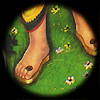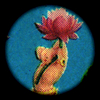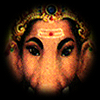
In the morning at Bhojbasa there was a fine frost. The sun was shining high on Shivling mountain but it took another hour and a half to reach the valley floor. Darren, an Australian who I had met, and I left midmorning for the two hour walk to Gamukh. Gamukh, or the cows mouth, is the tongue of the Bhagaratti glacier and the true source of the Ganga River. An Ice wall 150 feet high marks the spot. It is possible to climb up on the gravel covered ice for 30 or 40 feet to see a tiny rivulet of water seep from the ice, to touch the great Ganga river at its conception. Below the ice wall are a series of shallow pools. Here is the traditional location for taking a bath at the Ganga’s source. I am a confirmed chicken when it comes to cold water but fearing I would regret a missed opportunity I joined Darren in undressing to making an abbreviated jump into the water. As the cold water engulfed my head I felt a lighting flash of pain. But when I got out of the water I was exhilarated by the experience. As we sat on rocks to dry a group of men and boys arrived. They smiled at us, approving of our wet hair.

The Har ki Pairi is the central bathing ghat in Hardwar. This ghat is believed to be the exact spot where the Ganga leaves the mountains and begins its long journey across the Northern plains. A bridge from the shore provides access to a small narrow island in the Ganga river. Between the island and the adjoining shore a sluice is formed where pilgrims will make their ritual baths. My first visit to this place was in August when the heat was still intense and most of the bathers frolicked as much as they prayed.
The water traveling through the narrow sluice between the island and the shore moves very fast. To protect bathers from being swept away long metal chains with rings were fixed to the bathing steps. A popular sport was to grab hold of a ring and starting on the upriver side allow the water to sweep you along till the chain came taught. Braver souls would start on the up river side of the island and make a swift but difficult attempt to swim to the other shore. The stronger swimmers made the trip easily. For those who didn’t make it there was a series of chains with rings hanging off of the bridge. As a hapless soul came floating by they had one chance to grab a ring. If they didn’t it was out into the main river.

Varanasi is one of the seven sacred cities of India and is regarded by many to be the holiest. The city is built upon a high embankment of the Ganga river at a stretch where the river arks north. It is traditional for all pilgrims coming to Varanasi to bath in the river. As a holy city Varanasi is also an auspicious place to die and there is an active business in the cremation of bodies which is conducted along the riverbank. Furthermore the Ganga river provides both recreation and bathing facilities for a good many of the cities inhabitant. With so many varied activities taking place in the river its hard to imagine a seemingly more polluted body of water
On my third trip to the city I was staying in a guest house just a block away from the river. After watching hundreds of people bathe in the river I figured I had to give it a try myself. One morning I walked to narrow gully down to the Kedar ghat and joined about twenty men and boys in the morning bath. I was thoroughly enjoying the feel of the water when I noticed a large object about 40 feet way. When I got out of the river and put on my glasses I saw a dead cows spinning slowly in an eddy by the shore. My fellow bathers did not mind the site and continued their morning ablutions.

![]()
On the morning of Mankar Sankrati approximately 300,000 people were on the small Island of Ganga Sagar to bathe in the location where the Ganga exited out into the sea. It was low tide by the time morning light arrived and the masses were stretched across and abnormally large beach front. To reach open water required traversing extensive mud plains which is some places seemed to be over a half a mile in length. I rolled up my pants legs as far as possible and trekked out into the flats. I had just spent the entire night photographing while at the same time I was fighting an acute case of strep thoat. Out at the waters edge I photographed two older women as they returned from their dip. They looked in surprise at me with my camera. Then they smiled and wagged their heads in the distinctly Indian expression of acceptance.